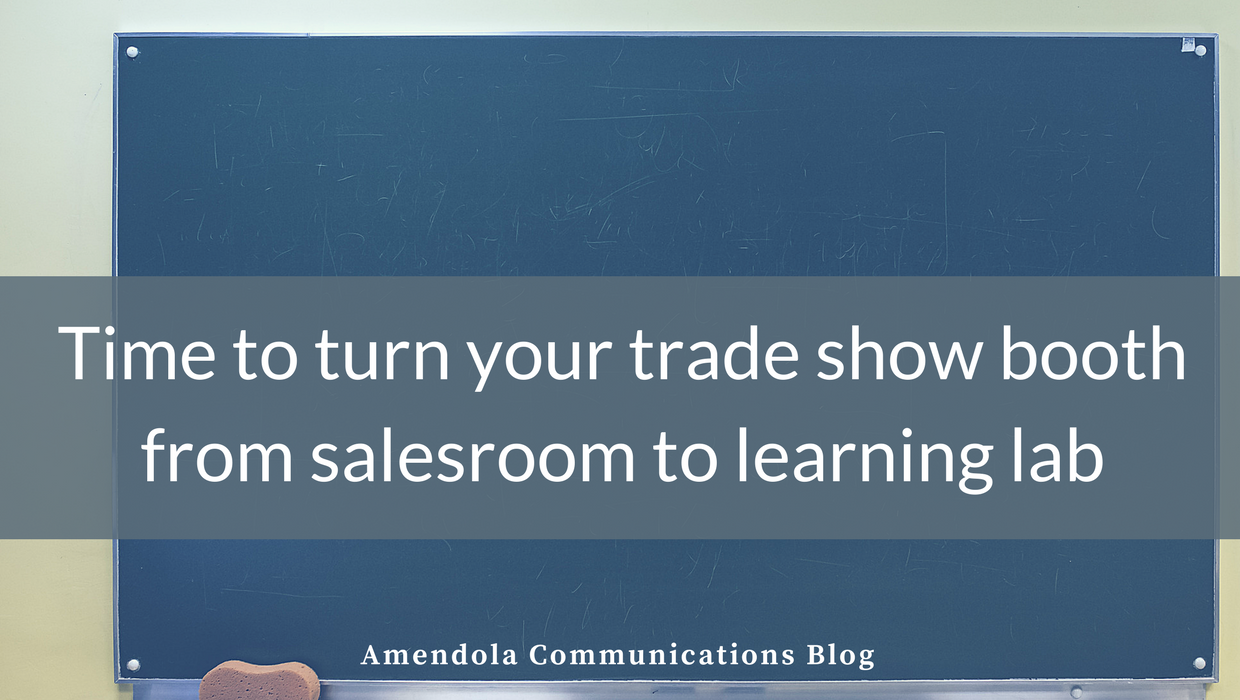“Be sure to bring back lots of product literature from the trade show,” said no one ever.
As my colleague Lisa Chernikoff pointed out in a recent blog, people simply don’t go to trade shows to buy your product. They go to learn. But when they approach your booth, what do they see to compel them to stay and learn something new? If you’re drawing a blank, it’s okay. That’s what this blog post is for: to show you some new ways to draw traffic in your booth and impart meaningful information that will “stick” with attendees well after they leave.
Strategy #1: Instead of a banner announcing your product or company, announce that “class is in”
Does your company address patient engagement, value-based care or some other hot concept in healthcare? Consider making your entire booth a class in this concept, with the appropriate banner, such as “Value-Based Care 101” or “Patient Engagement Pop-Up University.” And sure, by all means include “presented by (your company)” or your company logo. But make sure this is the secondary, less prominent message.
Strategy #2: Instead of a demo, offer a class or game
Once you’ve attracted the attendee’s interest with your signage, be sure to make good on its promise. Offer attendees an experience that imparts valuable knowledge to them. Here a customer champion can be recruited to give short 20-minute presentations about their success in addressing the theme of your booth, such as value-based care or patient engagement. To capture leads, have attendees register for the session. Make sure this isn’t a product pitch, though. While some mention of your product can be given, attendees want to hear a real world story from their peer not an infomercial.
A quiz that asks provocative questions paired with equally provocative answers is another effective way to make knowledge (and by extension, your company) “stick” with an attendee.
Even a standard product demo can be upgraded to a more experiential event. In one example, Medicomp, an Amendola client, takes attendees through a virtual experience in the form of a game, which is essentially a 3-minute product preview. It highlights the key capabilities and product features, as well as the streamlined user experience, in the context of winning a prize rather than buying a product. The experience gets attendees interested in learning more and helps to weed out the wrong people so the Medicomp team knows when it’s appropriate to invest time in a full demo.
Strategy #3: Instead of brochures, put out case studies, guides and other learning material
It’s not that product literature doesn’t have its place, but on its own, a brochure is most valuable to pack rats who can’t stand to throw anything away. But as Chernikoff bluntly notes in her blog, even that fate is unlikely.
“Nobody wants your marketing brochure! It will end up in the next trash can even if they take it, and if it makes it back to their room, it will end up in the hotel trash can. They also really don’t want a folder with multiple product one-pagers and a recent press release about your new product,” she writes.
A better idea, Chernikoff continues, is to give attendees material such as case studies that illustrate real-world scenarios while highlighting your unique value proposition. I would add to that guides, how-to’s, checklists and other learning material that, collectively, will make the reader far more knowledgeable on a topic than he or she was before.
Of course, the material should be compellingly written so that it will actually be read and if you are going to invest in producing this material, it’s wise to also invest in a professional writer to write it.
We’ve created a number of such pieces for various clients to use at their trade shows, including a compilation of “user tips and strategies” for Bayer to hand out at RSNA; a brief on new technology services and trends for the lab for 4medica to distribute at the Lab Confab; and case studies for our client HealthBI to pass out to attendees at a regional conference.
Strategy #4: Instead of cheap tchotchkes, raffle off a quality and related prize
In keeping with the educational theme of your booth, how about raffling off a mini-library of interesting books on the topic your booth addresses? (All the better if your company authored one of the books!) You could open up the raffle to anyone, or narrow it down to attendees of your various learning sessions. Be sure to offer to ship some or all of the books for free, as traveling with more than a few will be difficult for most attendees.
Another idea: give attendees a thumb drive titled “Teach Your Own Patient Engagement Class” or “Value-Based Care 102” or something similar that is stocked with educational content.
In conclusion, keep in mind that an educational trade show booth also aligns well with today’s information-hungry buyers. You’ve likely heard that when it comes to big ticket items, most people have made up their mind what they’re going to buy and from whom–before they actually reach out to a vendor. This is why so many companies have an educational, content marketing strategy in place today, and why it makes sense to take a similar approach with your tradeshow booth. Make it a place of learning and watch the traffic and good leads follow.
